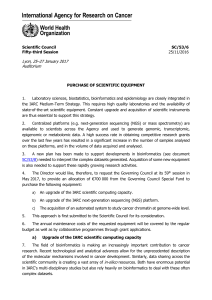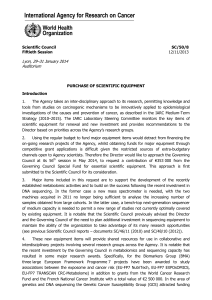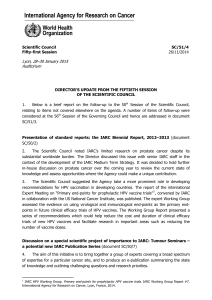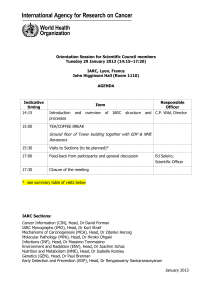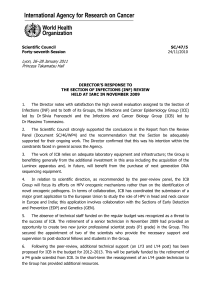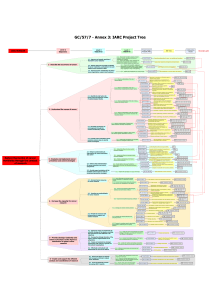Lyon, 27–29 January 2016 Auditorium
publicité
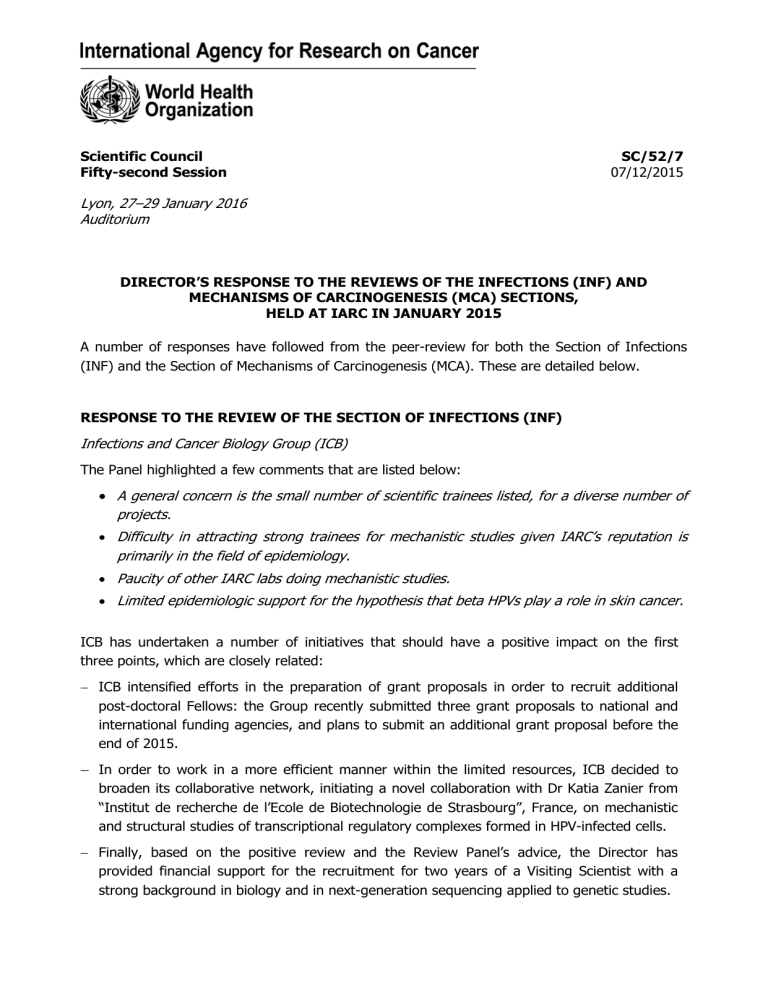
Scientific Council Fifty-second Session SC/52/7 07/12/2015 Lyon, 27–29 January 2016 Auditorium DIRECTOR’S RESPONSE TO THE REVIEWS OF THE INFECTIONS (INF) AND MECHANISMS OF CARCINOGENESIS (MCA) SECTIONS, HELD AT IARC IN JANUARY 2015 A number of responses have followed from the peer-review for both the Section of Infections (INF) and the Section of Mechanisms of Carcinogenesis (MCA). These are detailed below. RESPONSE TO THE REVIEW OF THE SECTION OF INFECTIONS (INF) Infections and Cancer Biology Group (ICB) The Panel highlighted a few comments that are listed below: • A general concern is the small number of scientific trainees listed, for a diverse number of projects. • Difficulty in attracting strong trainees for mechanistic studies given IARC’s reputation is primarily in the field of epidemiology. • Paucity of other IARC labs doing mechanistic studies. • Limited epidemiologic support for the hypothesis that beta HPVs play a role in skin cancer. ICB has undertaken a number of initiatives that should have a positive impact on the first three points, which are closely related: − ICB intensified efforts in the preparation of grant proposals in order to recruit additional post-doctoral Fellows: the Group recently submitted three grant proposals to national and international funding agencies, and plans to submit an additional grant proposal before the end of 2015. − In order to work in a more efficient manner within the limited resources, ICB decided to broaden its collaborative network, initiating a novel collaboration with Dr Katia Zanier from “Institut de recherche de l’Ecole de Biotechnologie de Strasbourg”, France, on mechanistic and structural studies of transcriptional regulatory complexes formed in HPV-infected cells. − Finally, based on the positive review and the Review Panel’s advice, the Director has provided financial support for the recruitment for two years of a Visiting Scientist with a strong background in biology and in next-generation sequencing applied to genetic studies. Scientific Council DIR’s response to INF and MCA Reviews SC/52/7 Page 2 Regarding the last point, there is a general limitation in the epidemiologic evidence for the role of beta HPVs in skin cancer, at least in part due to the fact that these viruses are highly ubiquitous in the normal population. In addition, the high heterogeneity of the beta HPV group and the possible existence of low- and high-risk cutaneous HPV types, as observed for mucosal HPV types, could lead to misinterpretation of epidemiological data available so far. Overall, this scenario highlights the importance of prior mechanistic studies on beta HPV types, which could significantly facilitate the design and interpretation of future epidemiological studies. Based on the mechanistic findings, one possible modification in the design of future epidemiological studies is to focus only on beta HPV types that display high transforming activities in in vitro and in vivo experimental models. For these research activities, we will continue to have strong links with epidemiologists in-house and in other institutes (e.g. Moffitt Cancer Research Center in Tampa, USA). Infections and Cancer Epidemiology Group (ICE) The Panel made a number of remarks that are listed below: • ICE’s new research direction in tonsillar cancers is innovative and should be supported, but ICE is a relatively new entrant to the HPV-tonsil cancer research field. • Revolutionary advances in HCV treatment will offer new opportunities for implementation research to prevent liver cancer. • The introduction of the nonavalent vaccine will require some adjustments to the HPV research programme. • The completion of after-vaccine surveys in both Rwanda and Bhutan is essential to the success of the research programme. The project on HPV carcinogenesis in the tonsil is indeed a new research area for ICE, and it is also a high-risk project since the assessment of normal tonsils has been so far rather frustrating, e.g. difficulties in obtaining samples and in HPV detection, and the existence of precancerous lesions in tonsils remains unknown. On the other hand, ICE has prior experience in HPV and oropharyngeal cancer. ICE seized therefore a special funding opportunity to run in France, with many distinguished ear-nose-and throat specialists, a technically difficult study that would have not been possible to perform in the developing countries. Even negative results might be useful to evaluate the possibility of early diagnosis/screening programmes for oropharyngeal cancer. Likewise, advances in HCV treatment offer new opportunities for implementation research to prevent liver cancer but IARC has difficulties to place itself, as a United Nations Agency, in a field that is mainly driven by pharmaceutical industries. The ICE Group is, however, performing meta-analyses of the global distribution of HBV and HCV, and would also be interested in developing transmission models addressing the potential impact of the treatment of HBV and HCV in the framework of the WHO Global Hepatitis Programme in which ICE participates. In respect to the advantages of the new 9-valent vaccine, ICE would like to stress that the advantages of switching to the new vaccine are still ill-defined on account of the uncertainties on the cross-protection conferred by earlier vaccines, notably the bivalent vaccine, and the additional cost of the 9-valent vaccine in developing countries. Those aspects, in addition to the SC/52/7 Page 3 Scientific Council DIR’s response to INF and MCA Reviews influence of age at vaccination and size of herd immunity, will be carefully evaluated in the HPV vaccination surveillance studies in Bhutan and Rwanda. As the Reviewers stated, the completion of post-vaccine surveys in both Rwanda and Bhutan is essential to the success of ICE’s research programme. The Group is trying to fine-tune its medium-long term plans to the strengths and weaknesses of two study countries that greatly differ in respect to population size and health system. RESPONSE TO THE REVIEW OF THE SECTION OF MECHANISMS OF CARCINOGENESIS (MCA) Overall recommendations for MCA 1. The MCA Section performs a variety of biomarker discovery projects. However, these projects should be followed-up long term, taking the identified biomarkers forward to other partners so that they can eventually be implemented in society. The Review Panel (RP) advises that this aspect of biomarker development be strengthened. This discussion with the Peer Review panel illustrated the different objectives of using biomarkers to understand the link between exposures, molecular alterations and cancer outcomes (as stated in IARC’s Medium-Term Strategy (MTS 2016–2020)), or to produce clinically validated biomarkers, for example for the early diagnosis of cancer. IARC scientists place all results in the public domain to allow further development of candidate biomarkers. The extent to which the Agency should actively seek to promote such developments, for example with the private sector requires further consideration. This topic will be brought to the Scientific Council for debate at its 52nd Session. 2. Although serious efforts have taken place to fulfil the needs for bioinformatics support (training scientists and technicians, forming a group at IARC of bioinformaticians), the RP feels that bioinformatics support to the MCA Section should be extended. The RP advises the addition of a P-level bioinformatician that can serve both EGE and MMB. The evolving need for bioinformatics support is relevant to all laboratory groups at the Agency. Centralized support for processing, analysis and integration of complex genomic and epigenomic profiles was strengthened by the recent recruitment of a Bioinformatics Assistant (shared by EGE and MMB as well as ICB). In addition, recent investments in bioinformatics in GCS (P3 Scientist in Bioinformatics) provide an opportunity for MCA to work in close collaboration with bioinformaticians across IARC. An internal review, coordinated by the Director, is currently examining the overall bioinformatics requirements of the Agency, including human resources and computing capacity, and investment in bioinformatics support across the Agency will be based on these strategic discussions. 3. Although the activities of both EGE and MMB have been focused considerably, the RP still feels that more focus on continuing research lines, instead of solitary projects, is desirable. The relatively broad research portfolio of EGE and MMB is to some extent a consequence of the interest shown by several Groups and Sections across the Agency to collaborate with MCA based on the new research areas and technologies introduced in the last two to three years. Scientific Council DIR’s response to INF and MCA Reviews SC/52/7 Page 4 Nevertheless, there is a need for further focus, with greater emphasis being placed on long-term projects on the main research priorities, defined as the study of molecular mechanisms and other molecular alterations associated with specific exposures and cancer risk factors. As detailed in the future research proposal, within the original document submitted to the Review Panel, EGE and MMB will primarily focus on three central projects, including a crosscutting theme, whereas several smaller projects will be discontinued. Importantly, EGE and MMB were recently successful in securing external funds (EC, NIH/NIEHS and two French major funding bodies), which will allow a greater focus on research relevant to these priority areas. 4. Both EGE and MMB publish well. However, the number of highest impact-factor papers that originates from MCA is limited. Focusing on research topics, building continuing research lines and more in depth analyses per project will increase the impact of the published papers and increase MCA’s visibility. Publication in academic journals is one of the key criteria for excellence in scientific quality and effectiveness, and MCA aims to publish in the highest impact peer review journals. This is certainly likely to be supported by the increased focus and depth on a narrower range of activities as specified above. However, it is important to emphasize that for the Agency this type of metric is not the primary objective. The laboratory work at IARC aims to improve understanding of the causes and prevention of cancer worldwide, including in the context of inter-disciplinary studies. This may not lead to publications in the highest impact-factor biomedical journals but should be interpreted in the light of IARC’s overall strategy. Epigenetics Group (EGE) The Review Panel provided several recommendations specific to EGE. Responses are provided briefly below: Research should seek a close linkage with the IARC Monograph Programme supported by human epidemiological and/or animal experimental evidence. As explained in the Review document, EGE initiated discussion with the IARC Monographs Programme to prioritize the study of agents that may act through epigenetic mechanisms. Current candidates include pesticides, endocrine disruptors, or agents classified in Group 2A or 2B, where the additional mechanistic information would help carcinogen evaluation by the Monographs programme. To facilitate future animal experimentation, the Agency is in the process of developing strategic partnerships with local centres of expertise, including SFR Biosciences in Gerland-Lyon with access to experimental animal facilities at the Platform for Experimental Biology on Mice (PBES) and imaging facilities. Analytical validity (including reproducibility, coefficient of variation, sensitivity and resolution, robustness against variable sample qualities and conditions, leukocyte subpopulation issue, etc.) should be avidly sought to adopt the epigenome methodology for epidemiological analyses. EGE has optimized and successfully applied new generation tools for the study of the epigenetic profiles in epigenome-wide and high-throughput settings (suited for molecular epidemiology studies). The extensive expertise gained in the development of analytical pipelines as well as SC/52/7 Page 5 Scientific Council DIR’s response to INF and MCA Reviews bioinformatics and statistical analyses will allow it to thoroughly interrogate the data generated in laboratory analyses. EGE is an international leader in the application of epigenome analyses in epidemiology and works closely with external collaborators in maintaining the research at the leading edge in terms of design and analysis. The RP encourages the collection of more basic data and knowledge, which should be compiled by the validated measurement methods to elucidate relationships between various exposures/confounders and blood methylation profile. The Group recognizes this requirement and is addressing it by putting particular emphasis on known and suspected risk factors, relevant to the cancer type under study, for which highquality epidemiological data are available for a wide range of exposures and potential confounders. The RP encourages the development of a grand strategic plan for IARC bioinformatics for the next 5–10 years in the age of data-driven life science integrating epidemiology, omics analyses of human biomaterials, high-throughput functional genomics and limited but growing molecular annotation/pathway data. This is being addressed in the context of the Agency-wide evaluation of overall needs for bioinformatics (see above a detailed response to Point 2 under the Section’s overall recommendations). Molecular Mechanisms and Biomarkers Group (MMB) The Review Panel provided several comments and recommendations specific to MMB. Some of these were in common with EGE or the overall evaluation (e.g. requirement for adequate bioinformatics support) and are not addressed again specifically for MMB. Other points are covered briefly below: Rise to a leadership position in public databases about exposure signatures. MMB is in discussion with the Wellcome Trust Sanger Institute, UK, about the Sanger’s COSMIC Database Signatures of Mutational Processes in Human Cancer to be formally transferred and maintained at IARC. MMB would serve as principal curator of the database, and would coordinate an international multi-centre collaboration aimed at validating newly submitted genome-wide signature patterns. The new MutSpec is very promising; it stands out particularly with regards to the IARC’s objectives. MMB appreciated the encouraging feedback and developed the MutSpec project further by establishing collaborations with the US National Toxicology Program (NTP) and the Japan Bioassay Research Center (JBRC). These allow systematic profiling of mutational signatures in rodent tumours induced by chemical carcinogens recommended by the Review Panel. Next, MMB is coordinating with the Wellcome Trust Sanger Institute, UK, and the Causes of Mutational Signatures Consortium (coordinators S. Jackson, D. Phillips and M. Stratton), to increase the impact of the MutSpec project through specific collaborative studies. In 2015, MMB secured external funds for this research area (three grants in total, one from NIH/NIEHS and two from the French national agencies INCa-INSERM and ANSES). Scientific Council DIR’s response to INF and MCA Reviews SC/52/7 Page 6 Complete the P2 staff recruitment at the earliest, in view of diverse areas of work within MMB. The recruitment has been successfully completed and the new P2 Scientist already significantly contributes to several key areas considered by the Review Panel, including the cross-cutting project MutSpec and the collaborative project (with EGE) on characterizing epigenetic modifiers in tumour development and their link to environmental carcinogens (EpiDRIVER). Develop more hypothesis-driven studies on the mechanism of carcinogenesis; consider the work of Van Deursen at the Mayo Clinic as a guide of the importance of senescence in vivo. With the arrival of the new P2 Scientist and of two postdoctoral Early Career Scientists in 2015, MMB is placing more emphasis on hypothesis-driven mechanistic studies including those focused on investigations of senescence bypass and cell immortalization following exposure to environmental carcinogens. The individual new projects are developed and carried out within the recommended research area framework.

